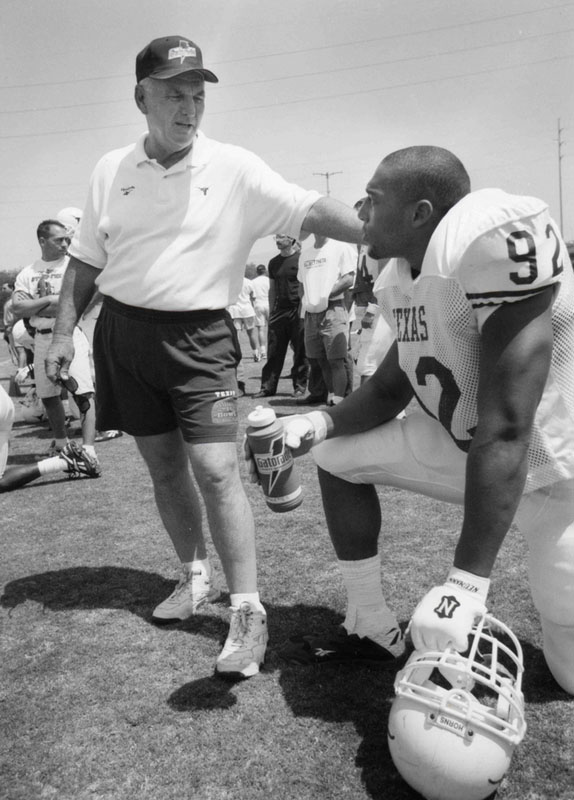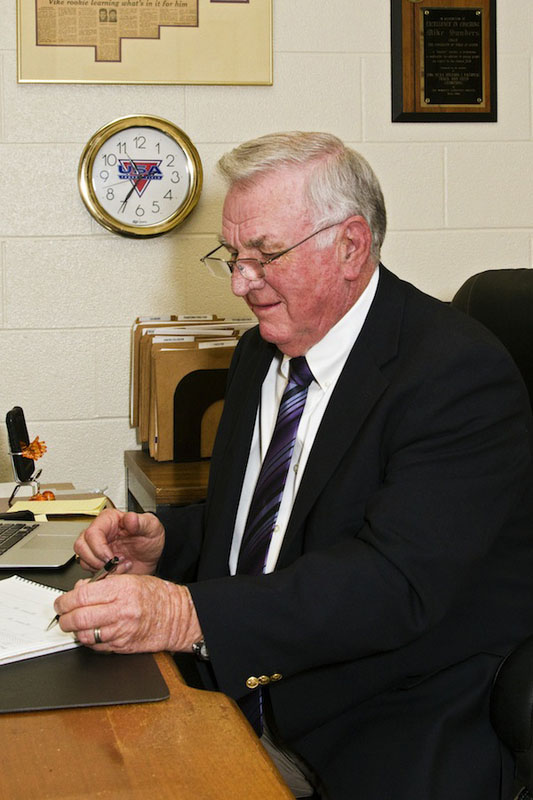Charlie Craven: Weight Training
During these early years, Craven borrowed weight training equipment from the Physical Training Program to use with his varsity athletes. “We started with Elmer’s weights out of West Texas,” recalls Craven. “Elmer had wrist weights and ankle weights. We had weight vests and so forth.” From there, Craven explained, they began using Universal Gyms that had been discarded by the Department of Physical Training for Men. When the physical education department would wear out a universal gym, the athletic department would say, “Hey, we can use this.” Finally, the Athletic Department decided to dedicate some of its own space for a weight room. Underneath the football stadium, up the ramp on the south end of the stadium was a large room numbered DL8. It had formerly been an athletic dormitory and was filled with old Army bunks, with no heat or air conditioning except for a couple space heaters, that had been used to house recruits who came for campus visits in earlier years. According to Craven, as the physical education department’s Universal machines broke down, “I’d make a deal for it, and we would take it down there, refurbish it, put it up, and we ended up with four of those, in that room. I was able to supplement that with a few other stations and that was where we began.
During most of the 1960s the programs used by the football teams at Texas were primarily circuit programs in which “an athlete would work as hard as he could for thirty seconds, and then had fifteen seconds to change to the next station and go as many as he could for another thirty seconds.” In the off season, Craven explained, this created some real challenges for him as he would have all the I offensive players for one hour and then all the defensive players for one hour.
Said Craven, “That became a little bit of a management issue because we had, roughly, 70 offensive and 70 defensive players. Because of this, I had to have 70 stations of some sort set up. I would blow the whistle, take on all of these characters and make sure that once they got to a certain spot that they didn’t slip off into the restroom and hide out for two stations.” Craven admits it was a nightmare to try and supervise a workout like that with only one coach in the weight room, “But, we survived well and won a couple of national championships with that process.”
One player who made a big difference in the acceptance of weight training by both coaches and other players was Tommy Nobis. Nobis, who grew up in San Antonio, had begun weight training before arriving at Texas. Nobis started as a sophomore on the 1963 National Championship team and averaged nearly 20 tackles a game before moving on to the Atlanta Falcons.
According to Craven, Nobis was a great natural athlete—but he was also a really hard worker in the weight room. As Craven recalls, “At that particular time in our history, we were concerned with shoulder and neck injuries and Tommy wanted his neck to be stronger than everyone’s. According to Craven, they fixed a special station for him so he could specifically train his neck, and, “when the other athletes saw Tommy doing that, and they watched him play, that helped create our interest in strength training a lot.”
By the 1970s the weight program for varsity sports had gained increasing acceptance and Craven was now fully in charge of the program. As acceptance for strength training had grown, however, Craven was finding it increasingly difficult to keep up with all the requests for assistance from various sports and so he asked for permission to hire shot-putting phenomenon Dana LeDuc as an assistant. Following his graduation from UT as an undergrad, LeDuc worked part time for Craven (who continued teaching in what was now called the Department of Kinesiology and Health Education, and supervising student teachers.)
The demands on Craven’s schedules finally grew to be so great, however, that he decided he had to step away. Leduc had proved to be an able assistant and so in 1977, Craven met with Darrell Royal and explained that he needed to retire as the strength coach. Craven recommended LeDuc to Royal and so, at a yearly salary of $10,000, Dana LeDuc became the first person at UT to hold the official title as "head strength coach".
Craven, continued assisting with the strength training after LeDuc was hired and was UT’s representative to the first meeting of the National Strength and Conditioning Association in 1978 in Lincoln, Nebraska. However, after Medina’s retirement, he He shifted his duties with Athletics into rehabilitation where he is still involved, even after retiring from the Department of Kinesiology and Health Education in 2008.
While Craven retired from Kinesiology, he has not retired from the Athletics Department where he still works with the football team overseeing injury rehabilitation. According to Jeff Madden, Assistant Athletic Director for Strength and Conditioning, Craven plays an invaluable role on that team.
“He’s the glue that holds us together,” said Madden. “He’s been an inspiring person, an incredible role model for the athletes, and I’ve watched him bring player after player back into shape after their injuries. He’s one of the most impressive and honorable men I’ve met in coaching, and it’s been a real honor for me to work with him all these years.”
When asked to think back on that earlier time, Craven said, “It was just so much fun to see those youngsters improve, even though it was through circuit training and we couldn’t get the pure strength, as we know it today, but they did get absolutely stronger and never entered a game, back in that time, where we thought the fourth quarter would be anyone’s business but the University of Texas at Austin. We took over. I get a lot of satisfaction out of seeing the strength and conditioning program today compared to where it was when I started. To tell you the basic difference, I tell you, back in that time, as I’ve said in earlier comments, I had the entire offense for one hour and the entire defense for one hour. I could not take into account the individual differences, individual needs by position, because that was the only time that Coach Royal would allow. Since I was working at his pleasure, I certainly followed his directions. So, that was the first model. Just circuit training. Now, we have every program and every sport is individualized to where every youngster has records on computers and we have normal progressions, periodization concepts, and all of this. We have taken science to a real new height in the strength and conditioning programs in America. We have done that here too at the University of Texas.”


